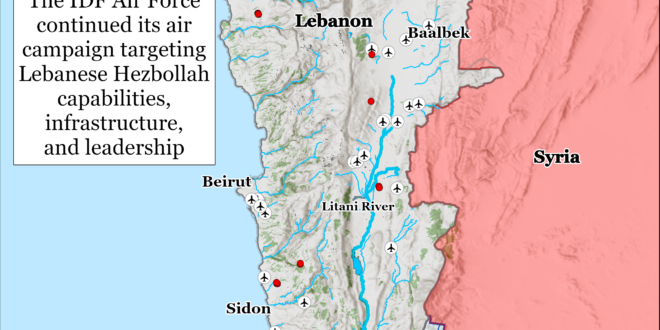An Israeli military correspondent reported that the Israel Defense Forces (IDF) is preparing to expand its ground operations in southern Lebanon.[i] The IDF plans to send more forces, according to the correspondent, which would build upon the two divisions already operating in southern Lebanon. These divisions have primarily operated around Lebanese villages immediately along the border with Israel.[ii] The expansion of Israeli operations would be meant to help achieve the stated Israeli war aim of returning displaced civilians safely to their homes in northern Israel. The near daily Lebanese Hezbollah attacks in northern Israel have compelled thousands of civilians to evacuate.
The IDF continued clearing Hezbollah infrastructure in southern Lebanon on October 5. The IDF 1st Golani Brigade (36th Division) raided Hezbollah positions and destroyed hundreds of weapons, including anti-tank guided missiles, grenades, and small arms.[iii] A Hezbollah-affiliated outlet described the activity as an ”intensive combing operation.”[iv] Hezbollah claimed that it detonated improvised explosive devices (IED) and fired rocket-propelled grenades targeting Israeli forces around Maroun al Ras and Yaroun on October 4.[v] The IDF 35th Paratroopers Brigade and 89th Commando Brigade (98th Division) also engaged Hezbollah militants and raided Hezbollah infrastructure in mountainous and urban areas.[vi] These brigades and Israeli engineering elements destroyed underground infrastructure, including tunnels. One of the sites was a Hezbollah compound 300 meters from the Israel-Lebanon border.
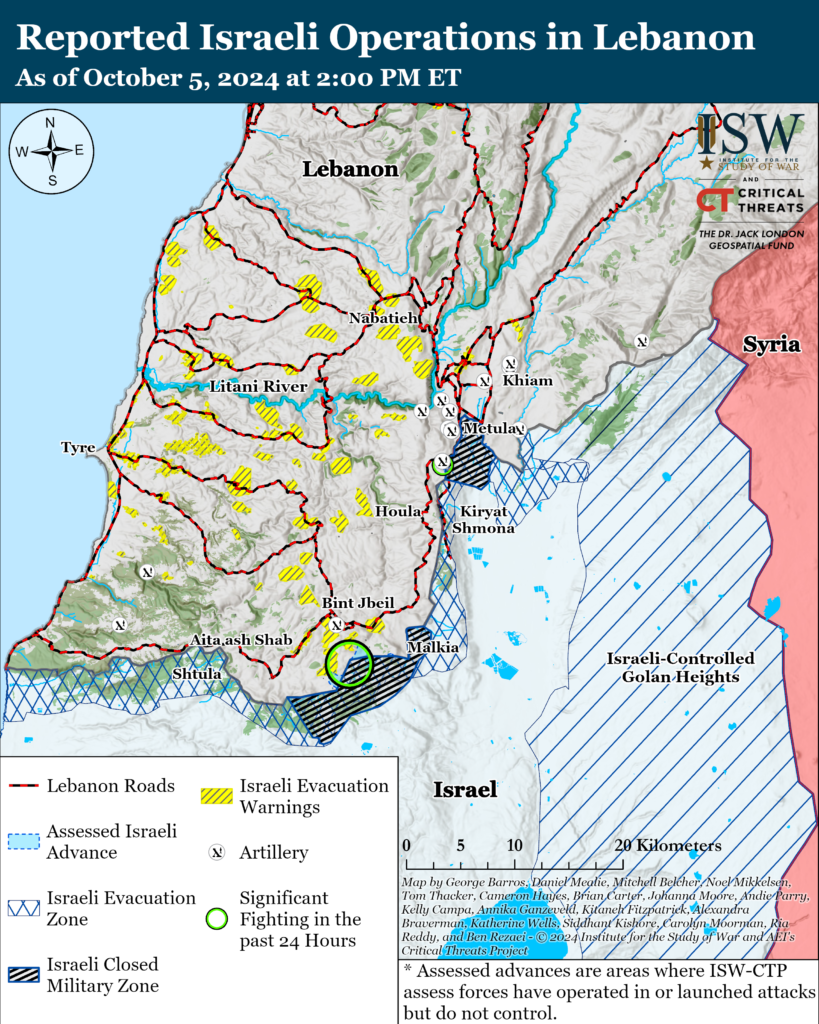
Hezbollah appears to be trying to avoid decisive engagements with the IDF. Israeli sources reported that Hezbollah is trying to keep its forces at a distance and will withdraw shortly after making contact with the IDF.[vii] Hezbollah is fighting primarily through ambushes and the use of anti-tank missile fire and IEDs.[viii] Hezbollah has also kept the bulk of its forces deep inside Lebanon rather than deploying them to the front.[ix] This behavior indicates that Hezbollah retains effective command-and-control at least at the tactical level and possibly higher, despite the extensive Israeli killing of Hezbollah commanders. The IDF has observed some indications that the combat effectiveness of some Hezbollah forces has been reduced, however.[x] The IDF announced on October 5 that it has killed about 440 Hezbollah militants since launching ground operations into Lebanon.[xi]
The IDF separately stated on October 5 that some Hezbollah militants have fled combat zones.[xii] Israeli media similarly reported that some Hezbollah militants have moved toward Lebanese Armed Forces (LAF) positions in order to evade Israeli attacks.[xiii]
The IDF continued its air campaign targeting Hezbollah capabilities, infrastructure, and leadership. The IDF conducted multiple airstrikes targeting Hezbollah infrastructure in southern Beirut on October 4 and October 5, including infrastructure affiliated with the Hezbollah intelligence apparatus and weapons depots.[xiv] The IDF warned residents to evacuate from specific buildings before some of the strikes.[xv] The IDF also struck Hezbollah militants in a mosque adjacent to Salah Ghandour Hospital in Bint Jbeil.[xvi] The IDF said that the Hezbollah militants used the headquarters to plan attacks against Israeli forces and into Israel.[xvii] The IDF said that it called local authorities in Bint Jbeil to demand that Hezbollah activities within the hospital end immediately prior to the strike.[xviii]
The IDF also continued to target Palestinian militia networks in Lebanon.[xix] The IDF said that it killed Hamas official Muhammad Hussein Ali al Mahmoud in Saadnayel in the Bekaa Valley.[xx] The IDF said that Mahmoud was a senior official in Hamas’ wing in Lebanon and played a significant role in growing Hamas’ presence there, providing Hezbollah with weapons to attack Israel, and directing attacks in the West Bank.[xxi] The IDF also killed senior Hamas member Saeed Alaa Nayef Ali Mahmoud in a Palestinian refugee camp in Tripoli, Lebanon.[xxii] The IDF said that Ali led attacks against Israel and recruited Hamas fighters in Lebanon.[xxiii] Hamas mourned the two fighters.[xxiv] Hezbollah commonly allows Palestinian groups to launch attacks into Israel from Hezbollah-controlled territory in Lebanon.[xxv] The IDF has targeted numerous members of Palestinian militias in Lebanon since beginning its intensified air campaign on September 21, including militants from Hamas, Palestinian Islamic Jihad (PIJ), the Popular Front for the Liberation of Palestine (PFLP), and the Popular Resistance Committees (PRC).[xxvi]
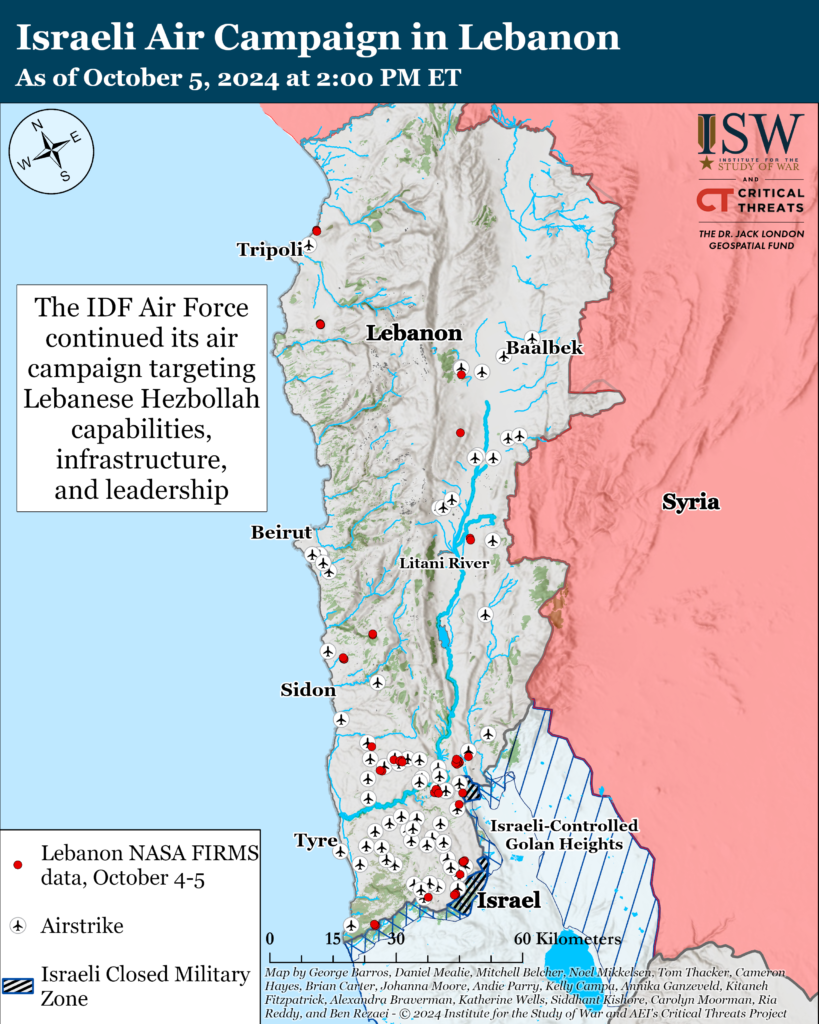
This map illustrates individual Israeli air and artillery strikes based on local Lebanese reporting. This map depicts strikes reported from 2:00pm ET on October 4 to 2:00pm ET on October 5. This map is not exhaustive. CTP-ISW cannot independently verify the locations of Israeli strikes.
continued its attack campaign targeting civilian and military locations in Israel. Hezbollah has conducted at least nine attacks into northern Israel since CTP-ISW’s last data cutoff on October 4.[xxvii] Hezbollah launched Fadi-1 missiles targeting the Ramat David airbase southeast of Haifa.[xxviii] Hezbollah separately launched rockets at the Maale Golani Barracks in the northern Golan Heights.[xxix] Hezbollah also claimed to launch rockets at civilian targets, including Sasa and Safed.[xxx] Hezbollah also continued to attack Israeli troops concentrated around the Israel-Lebanon border, including by firing large barrages of rockets at Dan and Katzrin. [xxxi] The IDF intercepted a suspicious aerial target that crossed into Israeli territory from Lebanon on October 5.[xxxii] The IDF conducted ”many interceptions” of Hezbollah rockets in the Karmiel area on October 5.[xxxiii] Some rockets fell in open areas.[xxxiv] Israeli media reported that Hezbollah rockets lightly injured three people in Deir al Asad near Karmiel.[xxxv] Hezbollah claimed to target the Elta Military Industries Company in Sakhnin near Karmiel.[xxxvi]
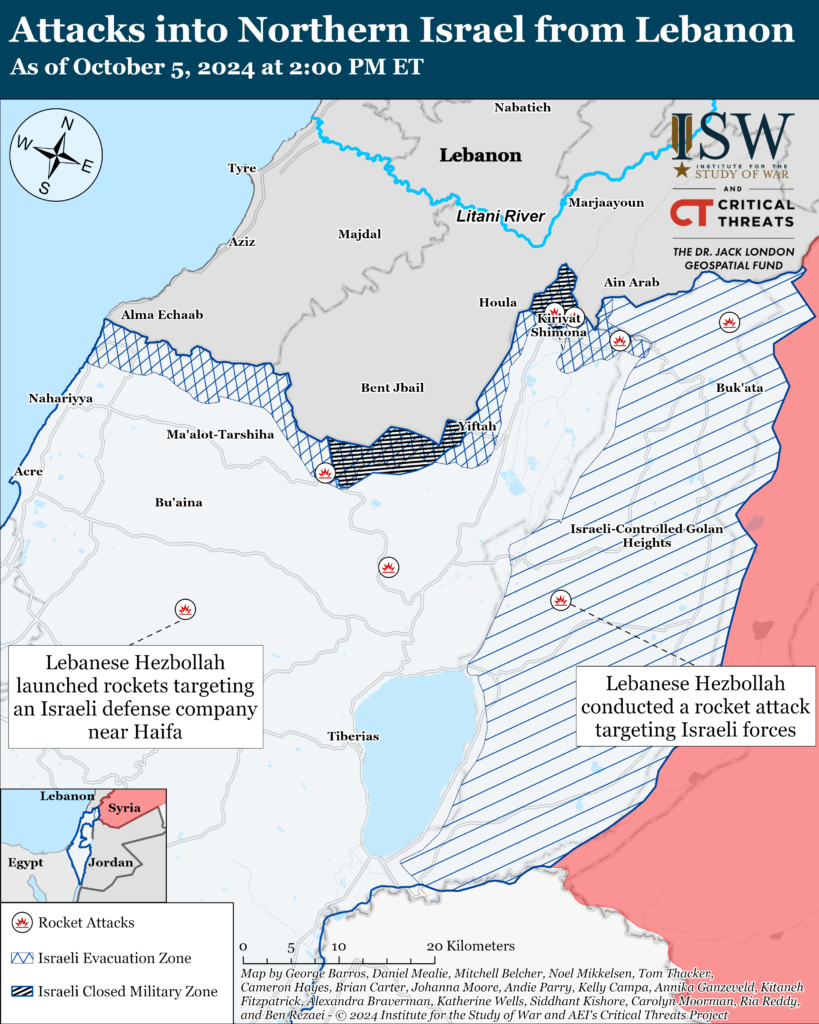
The IDF is still verifying whether Hashem Safi ed Din—the presumed successor to Hassan Nasrallah—died in an Israeli airstrike in Beirut on October 3.[xxxvii] An Israeli military correspondent reported that Israel expects the status of Safi ed Din to become clear in the coming days.[xxxviii] A Lebanese source told CNN that Hezbollah lost contact with Safi ed Din and has not heard from him since the Israeli airstrike.[xxxix]
Israel is preparing a “serious and significant” response to the Iranian missile attack on Israel on October 1.[xl] Israeli Prime Minister Benjamin Netanyahu said on October 5 that Israel is obligated to respond to the Iranian attack.[xli] An Israeli military correspondent reported that Israel expects ”significant cooperation” from its regional partners.[xlii]
The United States is increasing its force presence in the Middle East amid direct conflict between Israel and Iran. The US Department of Defense announced on September 30 that it is sending a “few thousand more” troops to the region in addition to the 40,000 US service members already there.[xliii] An anonymous US defense official said that the new deployments would include 2,000-3,000 more troops and three fighter squadrons.[xliv] US President Joe Biden said that the deployments are meant to protect American service members and defend Israel.[xlv]
Hamas leader Yahya Sinwar appears to have no intent of concluding a ceasefire-hostage agreement with Israel, according to anonymous US officials speaking to the New York Times.[xlvi] The US officials said that Hamas has shown no interest in negotiating with Israel in recent weeks. US intelligence agencies have assessed that Sinwar “cares more about inflicting pain on Israelis than helping Palestinians,” according to the New York Times. The US officials also described Sinwar as fatalistic and feeling that he will not survive the war against Israel. Sinwar, according to the New York Times, wants a greater war to erupt between Israel and the Axis of Resistance, calculating that it would alleviate Israeli military pressure on Hamas in the Gaza Strip.
The Islamic Resistance of Iraq—a coalition of Iranian-backed Iraqi militias—conducted five attacks targeting Israel on October 5.[xlvii] The Islamic Resistance of Iraq conducted three drone attacks targeting unspecified “vital targets” in northern Israel.[xlviii] The Islamic Resistance on Iraq also conducted two Arqab cruise missile attacks, with one targeting northern Haifa and the other targeting an unspecified target in southern Israel.[xlix]
Key Takeaways:
Lebanon: The IDF is reportedly planning to expand its ground operations in southern Lebanon. Israeli forces have primarily operated around Lebanese villages immediately along the border with Israel up until this point.
Lebanon: The IDF continued clearing Hezbollah infrastructure in southern Lebanon. Hezbollah appears to be trying to avoid decisive engagements with the IDF, which indicates that Hezbollah retains effective command-and-control at least at the tactical level and possibly higher.
Lebanon: The IDF is still verifying whether it killed Hashem Safi ed Din—the presumed successor to Hassan Nasrallah—in an airstrike in Beirut. A senior Lebanese source claimed that Safi ed Din has been out of contact since the airstrike.
Iran: Israel is preparing a “serious and significant” response to the recent Iranian missile attack on Israel. The United States has increased its force presence in the Middle East amid this direct conflict between Israel and Iran.
Gaza Strip: Hamas leader Yahya Sinwar appears to have no intent of concluding a ceasefire-hostage agreement with Israel. Sinwar reportedly wants a greater war to erupt between Israel and the Axis of Resistance to reduce Israeli military pressure on Hamas.
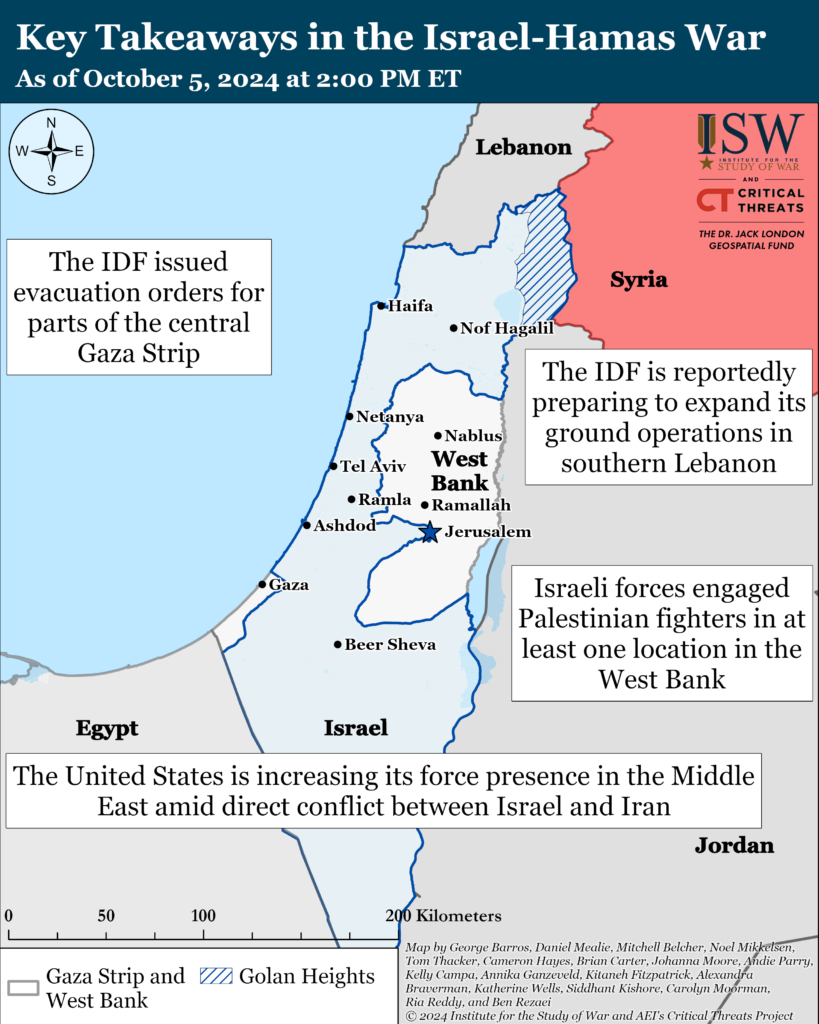
Gaza Strip
Axis of Resistance objectives:
Erode the will of the Israeli political establishment and public to sustain clearing operations in the Gaza Strip
Reestablish Hamas as the governing authority in the Gaza Strip
Palestinian fighters claimed no attacks targeting Israeli forces in the Gaza Strip on October 5.
The IDF continued preparations on October 5 for an expected rise in Palestinian militia activity to coincide with the anniversary of October 7.[l] Unidentified Palestinian militia groups in the Gaza Strip published a statement ahead of the anniversary, calling for Palestinians in Israel and the West Bank to” escalate the comprehensive resistance, especially the armed resistance.”[li] The IDF issued new evacuation orders for Bureij and Nuseirat in the central Gaza Strip on October 5.[lii] A Palestinian journalist reported that the IDF dropped evacuation leaflets northwest of the Nuseirat refugee camp.[liii] Israeli Army Radio reported that the evacuation orders are a part of IDF preparations for the anniversary.[liv] The correspondent added that the IDF was specifically trying to prevent Palestinian “mobs” breaking through the Netzarim Corridor to return to the northern Gaza Strip or militia fighters trying to raid the Netzarim Corridor. Israeli media reported that Israeli forces fired on dozens of Palestinians who approached the IDF around the Netzarim Corridor and posed a “threat.”[lv] Palestinian medical officials reported that the Palestinians were trying to return to their homes in the northern Gaza Strip.[lvi]
Israeli forces reportedly continued to conduct clearing operations in Gaza City on October 5. A Palestinian journalist reported gunfire from Israeli vehicles east and southwest of Gaza City.[lvii] A Palestinian journalist also reported “limited incursions” by Israeli forces east of Jabalia refugee camp.[lviii]
The IDF Air Force struck a Hamas command-and-control site in the central Gaza Strip on October 4.[lix] The IDF reported that the site was based in the former Ahmed al Kurd school in Deir al Balah.[lx] The IDF added that it took steps to minimize civilian casualties in the airstrike.[lxi] A Palestinian journalist reported that one child was killed, and several women and children were injured in the strike. [lxii]
Palestinian sources reported that Israeli forces conducted clearing operations east of Khan Younis on October 5.[lxiii] A Palestinian journalist reported heavy gunfire from Israeli vehicles entering al Santi area, near the Israel-Gaza Strip border.[lxiv] Hamas stated on October 3 that it conducted multiple attacks targeting Israeli armor east of Khan Younis near the Israel-Gaza Strip border.[lxv]
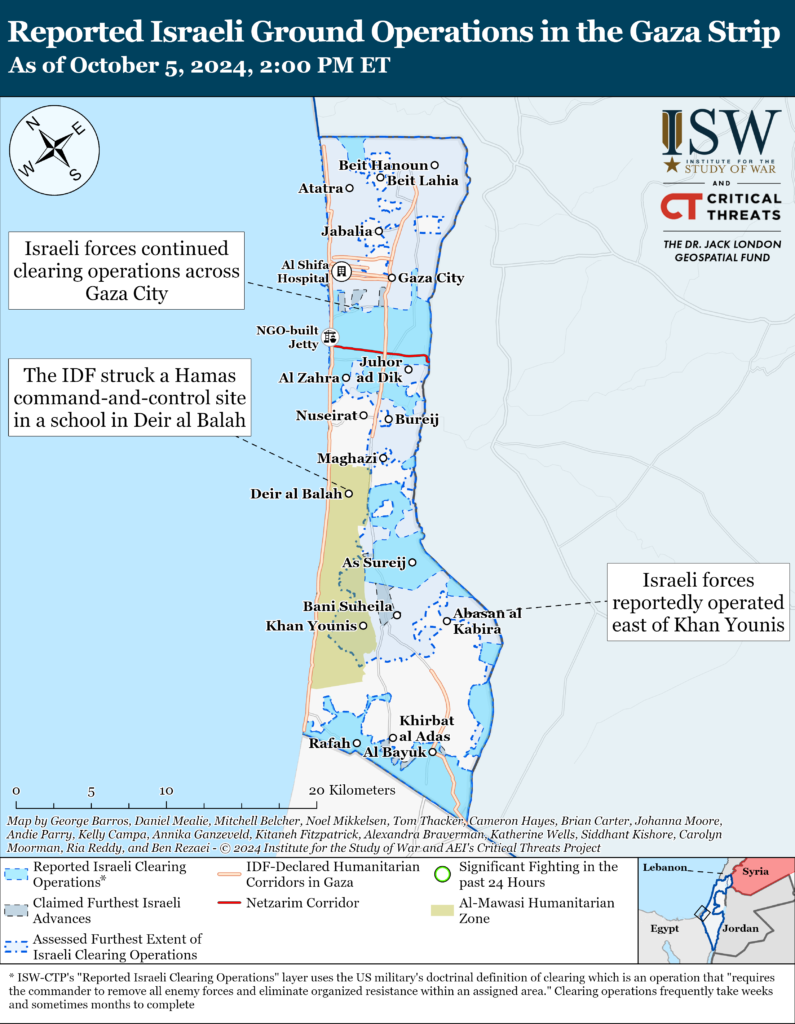
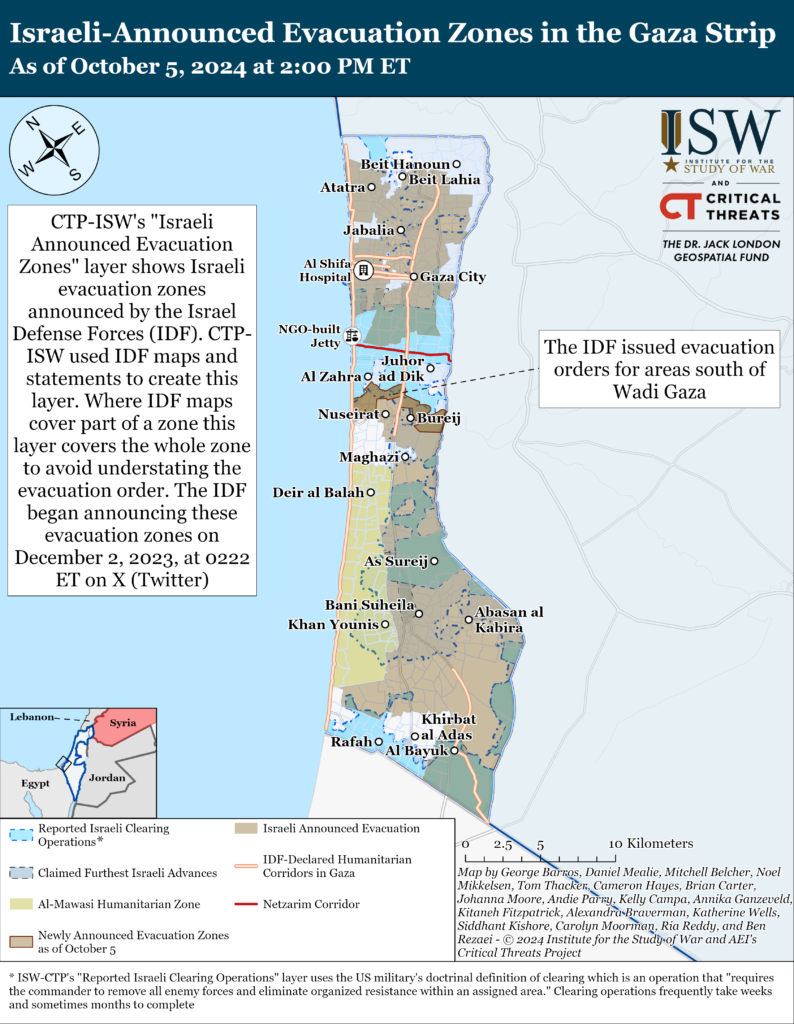
The Popular Front for the Liberation of Palestine claimed an indirect fire attack into southern Israel on October 5. [lxvi]
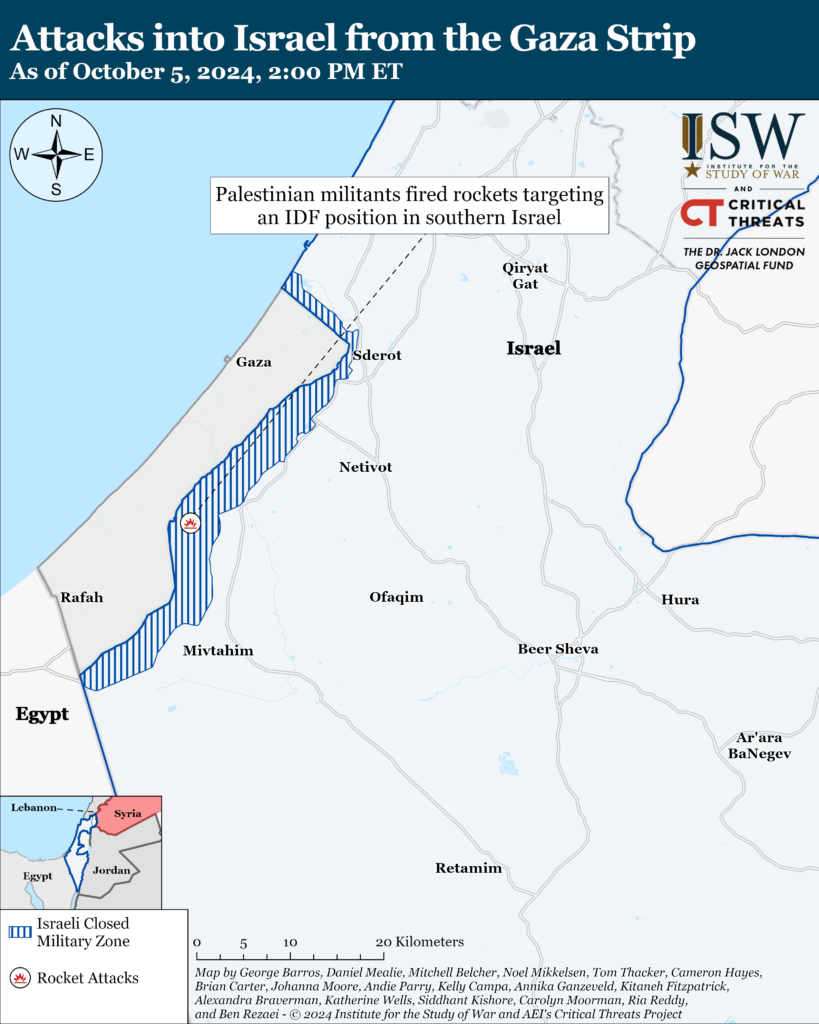
Recorded reports of attacks; CTP-ISW cannot independently verify impact.
West Bank
Axis of Resistance objectives:
Establish the West Bank as a viable front against Israel
Israeli forces have engaged Palestinian fighters in at least one location in the West Bank since CTP-ISW’s last data cutoff on October 4. The al Aqsa Martyrs’ Brigades fired small arms targeting Israeli forces near Tubas.[lxvii] This marks the first time that CTP-ISW has observed an engagement between Israeli forces and Palestinian fighters in the West Bank since October 1.
The IDF announced that it killed 12 Hamas and PIJ members in an airstrike on the Tulkarm refugee camp on October 4.[lxviii] The IDF confirmed that it targeted a building in the Tulkarm refugee camp where all 12 fighters gathered to plan an attack on Israel.[lxix] The IDF stated that all the fighters were involved in planning of attacks against Israel and producing explosives.[lxx]
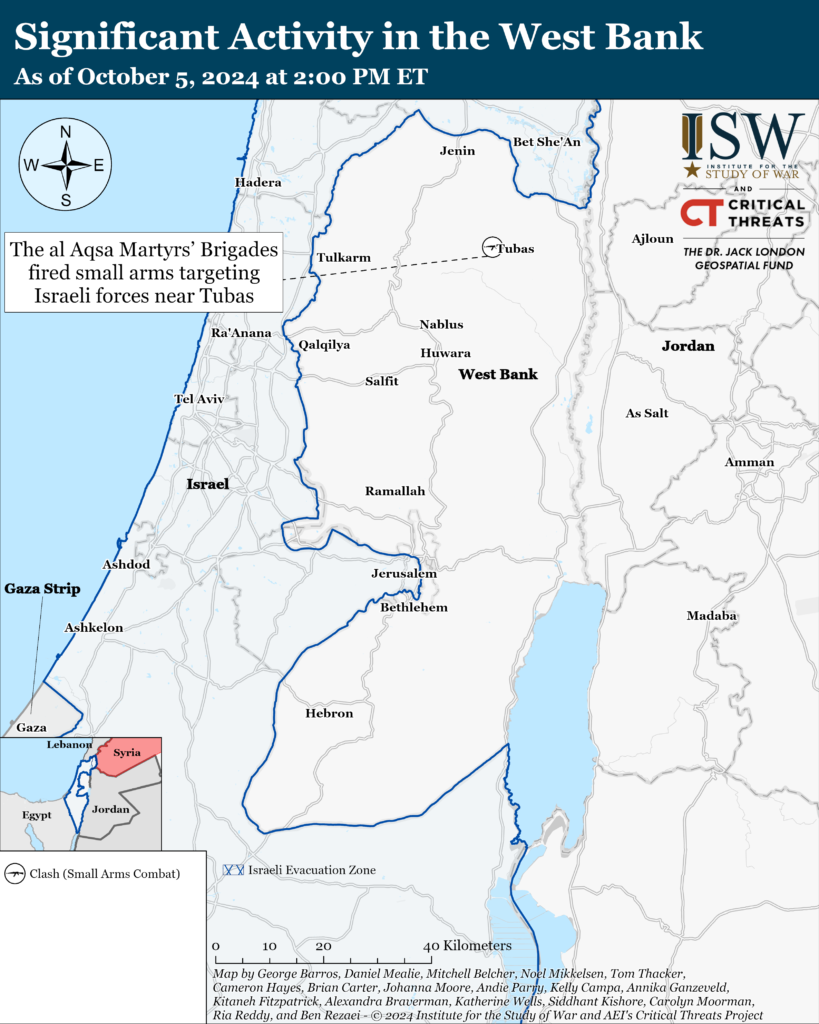
Northern Israel and Lebanon
Axis of Resistance objectives:
Deter Israel from conducting a ground operation into Lebanon
Prepare for an expanded and protracted conflict with Israel in the near term
Expel the United States from Syria
Lebanese Hezbollah has conducted at least nine attacks into northern Israel since CTP-ISW’s last data cutoff on October 4.[lxxi] See the topline section for more information.
Iran and the Axis of Resistance
The IDF Air Force reportedly conducted a drone strike killing a Syrian Arab Army (SAA) officer in Homs Province, Syria, on October 5.[lxxii] Syrian sources reported that an Israeli drone targeted a car, killing Sharaf Ghadir Hussein al Ahmad and injuring at least one other individual.[lxxiii] Syrian media claimed that Syrian air defenses tried to intercept the Israeli munitions.[lxxiv] The IDF also reportedly struck SAA positions in Daraa and Suwayda provinces on October 1.[lxxv]
US Central Command (CENTCOM) confirmed that it struck 15 Houthi targets, including offensive military capabilities, in Yemen on October 4.[lxxvi] These strikes follow the Houthis firing 23 ballistic and cruise missiles at three US destroyers near the Bab al Mandeb Strait on September 27.[lxxvii]
 Eurasia Press & News
Eurasia Press & News
